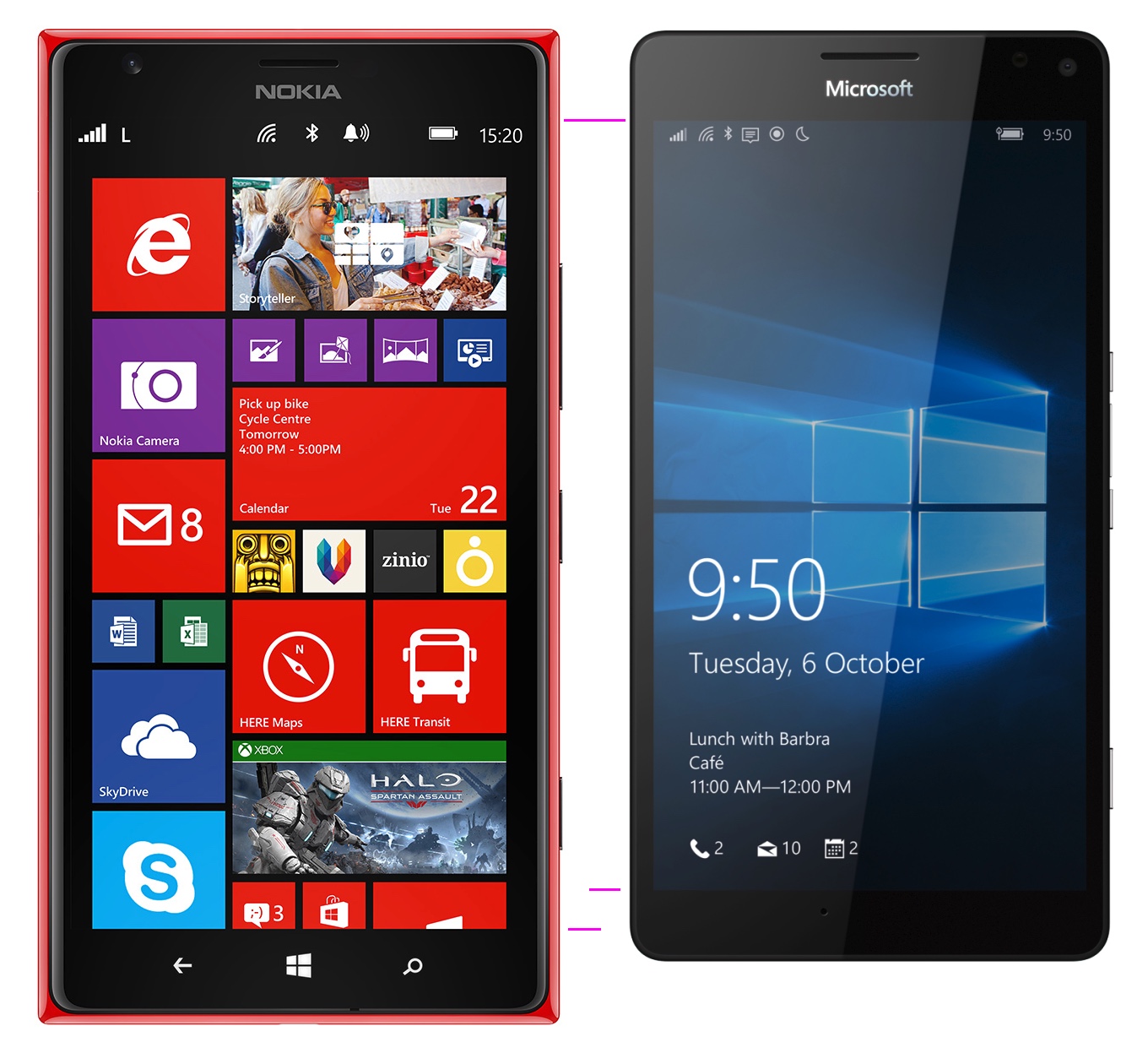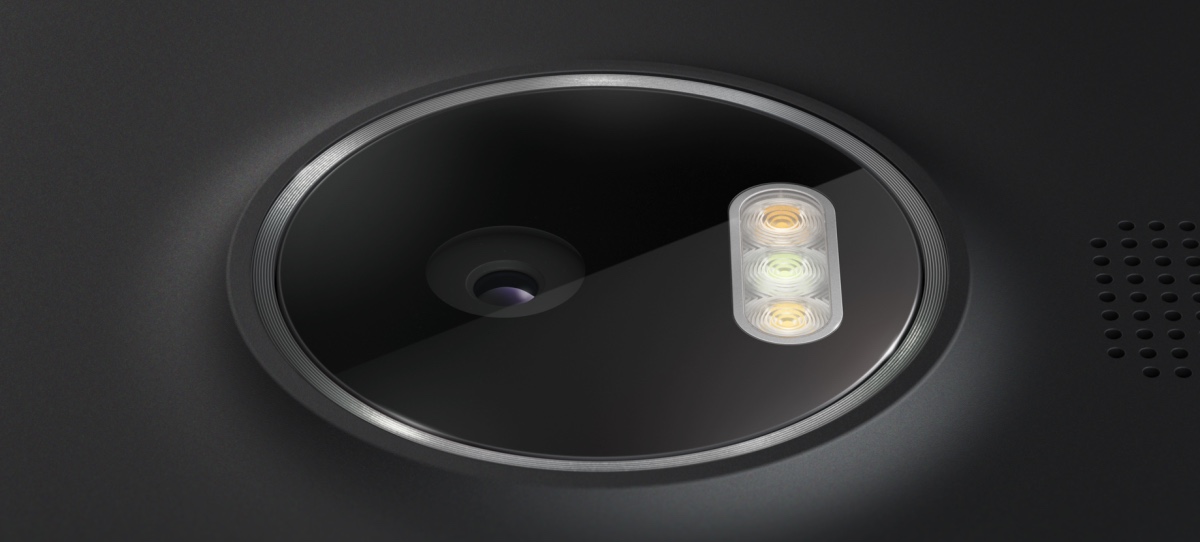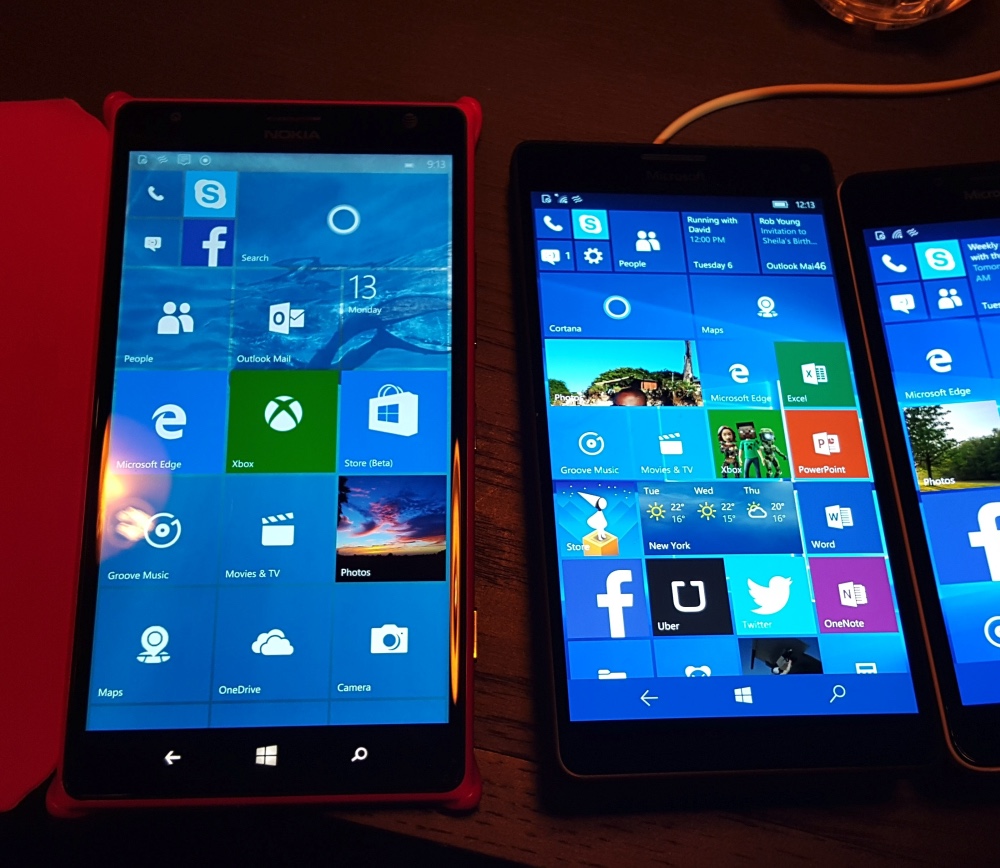
Much of what was announced at the huge (in significance) Microsoft event was arguably somewhat old hat to anyone who’s had a Lumia 1520 for the last two years. After all, a (nearly) 6″ screen? The return of Glance screen? microSD support? Yep, yep, and yep, all on the much older device. However, this is being totally disingenuous, as the overall package with the Lumia 950 XL knocks spots off the 1520 in many ways, not least that it’s a whopping 7mm narrower, with only a small 0.3″ reduction in screen real estate.
Now, 7mm may not seem a lot in the grand scheme of things, but I’ve reviewed enough devices to know that holding and carrying a 78mm-wide smartphone is just about practical, while 85mm is beyond the pale. It was for the Google Nexus 6, for example, which I tried living with for a week, and the 1520 is a full 2mm wider. In fact, when using the Lumia 1520 full-time, as an experiment, I kept losing the phone. What was happening was that the 1520 was too big for any of my pockets, comfortable, so I put it down beside me wherever I went – and then forgot to pick it up more than I’d like to admit.
So, yes, 7mm makes a big difference here, shown to scale on this page. The Lumia 950 XL can be carried more securely and pocketed more easily.

Showing the screen extents – 6″ vs 5.7″ displays, to scale….
I’m going to run through some of the other key differences, but I don’t want to head into yet another table here on AAWP – we’ve had far too many specs tables recently!
We’ve just had narrower, yet with minimal loss of screen real estate. In fairness, I should point out that the newer phone uses virtual Windows control keys, so when these are ‘up’, which is most of the time, then you’re down to about a 5.4″ screen – that may be significant if you absolutely must have the largest screen possible in a phone, all the time.
Then there’s faster. The Snapdragon 810 chipset benchmarks around twice as fast as the Snapdragon 800 in the Lumia 1520, though the two banks of processor cores do in theory mean that it can be twice as fast when it needs to be and more power efficient the rest of the time. Add in the 3GB of RAM (compared to 2GB on the 1520) and it’s clear that the Lumia 950 XL is going to fly. We know that Windows Phone was very efficient on more lowly processors and with lower amounts of RAM, and indeed my own tests show that Windows 10 Mobile runs quite acceptably on even the most lowly hardware – but if you’re in the market for a 950 XL then you don’t want ‘acceptably’, you want applications to open in a flash and for the interface to never present you with ‘resuming…’ Here, a factor of at least two (and possibly more) is a big deal, especially on the more ‘professional’ use cases, such as Edge (web) browsing and Office document handling.
A big draw to many will be the better camera too, despite the apparently similar baseline 20MP resolution. The sensor is totally different, in fact, with more sensitive pixels that produce lower overall noise, and with scattered ‘focus pixels’ that work with associated electronics to track the camera lens to the right point much more quickly than with traditional ‘contrast auto-focus’, in which the image needs to be received and analysed every time the lens is moved.

The sensor’s slightly bigger too, at 1/2.4″, but far more significant is the wider aperture, i.e. the physically larger and more advanced optics, at f/1.9 (compared to the 1520’s f/2.4), letting in almost twice as much light, meaning that all shots can be less noisy and that, in challenging light environments, the electronic shutter only needs to be open for half as long, so there’s less motion blur from human subjects. At least that’s the theory! OIS is still present, claimed to be ‘fifth generation’, despite the larger optical stack.
Add to these imaging improvements that the extra processing power from the main chipset enables faster shot to shot times and also more seamless burst mode and bracketed shot modes, including dual exposure intelligence in low light situations (blending short and long exposures) and yes, it seems that the camera in the 950 XL is another major plus point over its two year old ancestor. The 1520 already has some of the software features and may inherit more as when Windows 10 Mobile hits for real, but it’ll all work better on the newer phone.
Front facing imaging gets a big bump, with a 5MP ‘selfie’ camera, compared to the 1.2MP camera on the 1520. I doubt many people in the target market for a 950 XL are big on selfies, but it’s a nice little improvement regardless.
The display’s an interesting point, since ‘pentile’ 1440p (QHD) is arguably equivalent to RGB 1080p on the Lumia 1520, i.e. you get a higher nominal resolution, but you don’t get a full complement of red, green and blue pixels on each row/colomn in the display, so it all works out about the same in terms of perceived sharpness. The 1520 is usually reckoned to have one of the best phone displays ever created in all light conditions, but the 950 XL seems to have it equalled, albeit with the slight decrease in overall size already mentioned.

(Real world photo: the 1520, in a flip case, next to the 950 XL and (sneaking in on the right) the 950…. image credit PC World)
Battery life is quoted as slightly shorter than the 1520’s, with 100mAh less in the tank and with a faster processor and higher resolution screen to drive, though the difference in ‘talk time’ is small in the grand scheme of things. At this end of the power spectrum (i.e. well over 3000mAh) you’re guaranteed a full day of use whatever happens. Both the 1520 and 950 XL have Qi wireless charging, though the newer model streaks ahead here in flexibility with the return of the replaceable battery concept to the flagship Nokia/Microsoft DNA.
Then there’s the infrared iris scanner, enabling instant unlocking and, further down the line, the possibility of authenticating this way for payments and purchases. I’m a little old-school here and prefer the reliability of a password or PIN, but eye-scanning will be more convenient for many users, so why not?
Finally, the Continuum compatibility for the Lumia 950 XL means connection through to an optional big screened monitor, keyboard and mouse, making the smartphone more of a hub for all your communications and activities. I’m also a little sceptical about this technology – not because it doesn’t work, but because there are relatively few use cases which make sense. But still, it’s another useful future-facing string to the Lumia 950 XL’s bow – in contrast, the Lumia 1520 is limited to connection to a Bluetooth keyboard only, which is useful once you’ve propped the phone up on a kickstand, though that’s it – you can’t even connect a mouse (yet) and the interface is in many places limited to ‘portrait’.
Verdict
Looking at the specifications and functions, especially considering my (probably curmudgeonly) scepticism as to the iris scanning and Continuum, it’s apparent that I’m mostly right about the 950 XL being something of an incremental upgrade over the Lumia 1520, i.e. if you own the latter then you won’t notice much difference day to day, in terms of applications and speed, though the camera improvements are a real attraction to me personally.
However, you can’t ignore the physical. Those 7mm missing from the width of the phone, in taking the screen size down just 0.3″ (and yes, I know I’m mixing my units, but screen size continues to be measured imperially!), are hugely significant and make all the difference between ‘way too large’ and ‘useable’. And, for that reason alone, you should consider the 950 XL – if you already own the 1520 it’ll be a breath of fresh air in terms of portability!